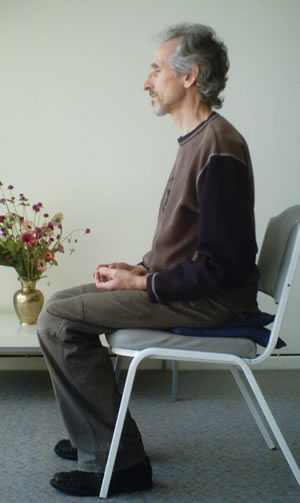Paramahansa Yogananda -
Basic Meditation Technique
Essential Parts of Meditation
First you exercise then you meditate following five steps:
1. Prayer
2. Chanting
3. Meditation Techniques (SRF Hong Sau, Aum, Kriya Yoga)
4. Sitting in the Stillness (Very important step!)
5. Practicing Devotion
![]()
1. Prayer: First is to begin with a prayer, invoking the presence of God and the Gurus in our meditation, asking Their guidance and praying that They give us what we need for our spiritual growth at this time. Pray from the heart, not from the mind.
2. Chanting: Singing a devotional chant helps us to concentrate our thoughts and awakens our love for God. It helps us to get in the mood for meditation.
3. Practice of SRF meditation techniques. When you practice them with concentration and devotion, they produce a state of deep peace and calmness.
4. Sit a long time in the stillness. It's essential! At least 15 minutes. "Stillness" means no restless thoughts, not even praying. Just be aware of the spiritual eye—keep the mind riveted at the Christ Center. That stillness comes with a sense of joy. As the Bible says,
"Be still,
and know that I am God."
(Psalm 46:10)
To have any spiritual experience, the body must be still, the mind must be still, and the feelings must be still.
What did you do in your meditation?
Devotee said, "I was talking with God".
What did you tell God?
"I didn't tell anything to God, I was listening"
Then, what did God tell you?
"He did not tell anything either, He was also listening"
5. Practice Devotion: when the body and mind begin to get restless after sitting in the stillness as long as you can, that is the time to practice devotion. Talk to God from the heart.
![]()
Basic Meditation Technique
 Sit on a straight chair, or in a cross-legged position on a firm surface. Keep the spine straight and the chin parallel to the floor.
Sit on a straight chair, or in a cross-legged position on a firm surface. Keep the spine straight and the chin parallel to the floor.
If you have assumed the correct posture, your body will be stable, yet relaxed, so that it is possible to remain completely still, without moving a muscle. Such stillness, devoid of restless body movements and adjustments, is essential to the attainment of a deep meditative state.
With the eyelids half closed (or completely closed, if this is more comfortable to you), look upward, focusing the gaze and the attention as though looking out through a point between the eyebrows. (A person deep in concentration often "knits" his brows at this spot.) Do not cross the eyes or strain them; the upward gaze comes naturally when one is relaxed and calmly concentrated. What is important is fixing the whole attention at the point between the eyebrows. This is the Christ Consciousness center, the seat of the single eye spoken of by Christ: "The light of the body is the eye: if therefore thine eye be single, thy whole body shall be full of light" (Matthew 6:22). When the purpose of meditation is fulfilled, the devotee finds his consciousness automatically concentrated at the spiritual eye, and he experiences, according to his inner spiritual capacity, a state of joyous divine union with Spirit.
A breathing exercise to prepare for meditation...
When you are established in the meditation pose just described, the next preparation for meditation is to rid the lungs of accumulated carbon dioxide, which causes restlessness. Expel the breath through the mouth in a double exhalation: "huh, huhhh." (This sound is made with the breath only, not the voice.) Then inhale deeply through the nostrils and tense the whole body to a count of six. Expel the breath through the mouth in a double exhalation, "huh, huhhh" and relax the tension. Repeat this three times.
Concentrate on the peace and joy of the soul...
Remain calm... Bid adieu to the world of sensations —sight, hearing, smell, taste, and touch —and go within, where our soul expresses itself....
Dismiss all sensations of the body; dismiss all restless thoughts. Concentrate on the thought of peace and joy. (from SRF Magazine)
![]()
In the first stage of meditation, the devotee's mind is inextricably bound up with sense consciousness. His mind is concentrated upon material sounds and restless thoughts. He is aghast to behold all the forces of restlessness and mental opposition arrayed against him. Millions of superficial devotees never pass beyond this state of deadlocked psychological struggle between the senses and the soul forces of calmness and intuition.
The devotee who is victorious in the initial psychological battle enters the second state of meditation, the metaphysical battle wherein his consciousness and life energy become centralized in the spinal centers. He sees himself as a warrior on the battlefield of the spine—the common field of spiritual forces and of the opposing mental or sense tendencies in their subtle form. When this battle is about to begin, the devotee feels a simultaneous pull toward the outgoing sense tendencies in the spinal centers and toward the inwardly turned spiritual forces of the soul. It is then that the devotee contacts the calm Spirit within and prayerfully asks that Divine Power to place the chariot of intuition between the subtle divine perceptions and the gross sense perceptions. The devotee expects, with the aid of the Spirit, to rally his forces of meditation to fight the forces of restlessness. (bg)
![]()
Further Readings: Meditation